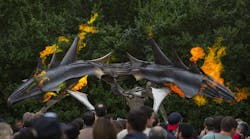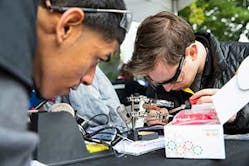Maker Faire is a large movement that started over 10 years ago with Dale Dougherty and Sherry Huss. While this movement might be inspiration for kids, at this year’s New York City event the median age of attendee was 40. This event has branded itself in many ways to build bridges and collaborate across disciplines to unite technologies and different creative mediums that inspire conversations that may have not have happened otherwise. This blending of people is imperative to the fair’s message. Furthermore, the founders saw the need for human interaction and value in meeting face-to-face to create lasting memories and relationships that continue to expand the faire that has become a movement. Machine Design was fortunate enough to talk with co-founder Sherry Huss about how this whole crazy show got started.
What is your background?
I have a business degree from Ohio State University, but my entry into the career world was through book publishing. I worked in sales with a textbook publisher. From there I went into software publishing. This is a time where it was a lot of Lotus 123. Eventually I started with Ziff-Davis that was an electronic publisher where things started to gel for me. Being on the consumer side of different types of communities I was responsible for figuring out how to pull together these communities for different audiences. Then, about 20 years ago, I segued into events where I launched JavaOne in 1996.
Where did the Maker Movement start?
I was always in the technology side, the developer side, and this is where I met Dale Dougherty – the other co-founder of Maker Faire. At that time Dale had come up with an idea Web 2.0 as the next generation of the web around 2001 or 2002. An interesting note is that Web 2.0 was declared the millionth word in the English dictionary. He was also launching a series of books called “Hacks.” This is when he found a particular group of people. They would often buy a product, then “hack” it to suit their needs.
This group of people tended to be engineers. However, even if there title was engineer, they often were managers, or project managers. While they took their careers serious, they weren’t “Making” on the job. This would lead these engineers to have a basement or garage where they would be able to scratch their creative, “Maker” itch.
This is where Dale first put a name to the group, and called them Makers. This didn’t require you to be an engineer, or have a degree, just that you are passionate about it. Making started in the tech world. However, as we started putting together an event, we realized Making transcended all disciplines. This led to Dale to publish the Make magazine in 2005. It was predominately men in the engineering trade, but it was open for anyone with that creative passionate spirit.
I saw Dale had posted, How to Build a Geeked Up Haunted House on the website and said let’s build one. As we put the event together, we talked about what a real-time event to celebrate Makers would look like. This was when Dale had the idea for Maker Faire and In Fall 2005 to spring 2006 our first Maker Faire was born.
How do you manage to make such a diverse group feel welcome?
Welcoming diversity was the plan all along and some of the ideas were meant to transcend age, gender, and cultures. In 2006 there were a lot of Indy craft groups that were starting, so we started working with Bazaar Bizarre to curate craft faire areas that were handmade. Then we started aggregating that with other communities. Some communities we already knew, such as rocket makers, small engine building clubs, etc. and then we reached out to other communities we weren’t as familiar with. we simply asked if they wanted to join us and gave them a space to collaborate with the other communities.
One of our visions was to curate a collaborative group. Early on, we noticed the robot group would only talk to the robot group as an example. However, value was to get these group together and start collaborating. We didn’t know if it was going to work, but we rented a fair ground to find out. Just like any state or county fair, we were just trying to bring together a community to celebrate and share.
This year I think we’ll be shy of 200 fairs around the world. Maker Faires are in about 35 other countries and have about 1.5 million attendees. It was surprising that we didn’t really have an issue with getting attendees or Makers to show up. We had a harder time to find sponsors. This led us to pull back in 2009. However, we still had many people that were asking for us to bring a faire to their area. This led to the idea to create a licensing model to bring interdisciplinary, hands-on, family friendly activities to all the areas.
All of the above. This has become such a large community with such a wide scope its hard to highlight any one thing. We do have Zero to Maker, which might be someone new or young. They might not know how to make, but they just want to get involved. Then we have Maker to Maker, which are Makers that are less interested in making money and just enjoy making. Maker to Market are Makers that are looking to take something to market. We see a lot of them networking, looking for investors, and using crowd sourcing.
What do you think were the factors that lead to the success of this movement?
Looking back at when the Maker movement, it really gained momentum about 2009, which was during the recession. People were looking for employment or other options. Also, I feel parents are increasingly frustrated with the education system, so as we got momentum I think parents saw this as a way to educate their kids in a positive exciting way. Another big component was hosting a live event that was face-to-face. You can communicate online, and over the phone, but an event like this get people together which forms an experience or relationship we haven’t found a way to digitize yet. so the timing, face-to-face interaction, and inclusive nature with the recession and current state of education were all factors.
What have you done to help the current problems in education?
Our model is similar to a school science fair, so we have generated The School Maker Faire. It’s essentially a Maker Faire in a box. What might be more interesting for our brand is that we don’t have a winner. We aren’t targeting the few overachievers. While over-achievers are more than welcome, they will most likely show up on their own. We are trying to get everyone, especially the non-traditional thinking students. Maker Faire isn’t to highlight the few but empower the community.
Dale also started a non-profit – makered.org – that helps empower teachers and communities to facilitate meaningful making and learning experiences with youth. I think it is interesting to note that none of this is to generate curriculum. We feel that you don’t tell a gardener how to plant seeds, they just need a plot of land. A big part of our work is to help find space for Makers. However, these are just a few things associated with this movement. We work with FIRST Robotics Competition, and there is even a camp. Google help launch a Maker Camp, 2017 will be our sixth year, and list goes on.
Where do you see this movement heading?
We seem to have gotten away from some simple things. Making food became commercial and automated. This seems to have led to a community that doesn’t understand where food comes from or how to cook. We cut home economics, now something as simple as feeding kids or teaching them to cook seems difficult. Now we see programs such as The Green Bronx Machine – an inner-city program that has students growing their own vegetables.
We cut shop and now no one fixes things - granted it might be more difficult to repair some things. However, this has led to a community of fixers, websites, Maker Spaces, Hacker Space, and more. Even YouTube channels like Jimmy Diresta that show how to build and fix things are gaining in popularity.
Overall, I see this moving towards a more communal type living and works. Kids are dropping out of school because they are bored and don’t feel they are learning anything. Then they find one of these communities and suddenly they want to learn more and thrive because the support and excitement of hands-on or applied learning.
We need to support people’s creative knowledge and motivate them. In order to recognize this, you need a community to support you. Communal works does not mute individuality; it can support and promote it.




